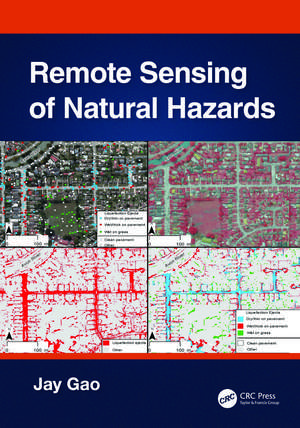Remote Sensing of Natural Hazards
Autor Jay Gaoen Limba Engleză Hardback – 16 iun 2023
1. Covers all major natural hazards including hurricanes, tornadoes, wildfires, and avalanches.
2. Studies each natural hazard holistically, ranging from spatial extent, severity, impact assessment, causes, and prediction of occurrence.
3. Explains different remotely sensed data and the most appropriate method used.
4. Compares different ways of sensing and clarifies the pros and cons of any selected data or their analysis.
5. Provides ample examples of each aspect of a natural hazard studied augmented with graphic illustrations and quality assurance information.
All professionals working in the field of natural hazards, senior undergraduate, and graduate students, will find in-depth approaches and sufficient information to become knowledgeable in the methods of yielding and analyzing data provided with remote sensing technology, ultimately providing a deeper understanding of natural hazards.
Preț: 916.65 lei
Preț vechi: 1117.87 lei
-18% Nou
Puncte Express: 1375
Preț estimativ în valută:
175.41€ • 187.56$ • 146.25£
175.41€ • 187.56$ • 146.25£
Carte tipărită la comandă
Livrare economică 17 aprilie-01 mai
Preluare comenzi: 021 569.72.76
Specificații
ISBN-13: 9781032404028
ISBN-10: 1032404027
Pagini: 463
Ilustrații: 138 Tables, black and white; 25 Line drawings, color; 13 Line drawings, black and white; 135 Halftones, color; 11 Halftones, black and white; 160 Illustrations, color; 24 Illustrations, black and whit
Dimensiuni: 178 x 254 x 25 mm
Greutate: 1.18 kg
Ediția:1
Editura: CRC Press
Colecția CRC Press
ISBN-10: 1032404027
Pagini: 463
Ilustrații: 138 Tables, black and white; 25 Line drawings, color; 13 Line drawings, black and white; 135 Halftones, color; 11 Halftones, black and white; 160 Illustrations, color; 24 Illustrations, black and whit
Dimensiuni: 178 x 254 x 25 mm
Greutate: 1.18 kg
Ediția:1
Editura: CRC Press
Colecția CRC Press
Public țintă
Postgraduate, Professional, and Undergraduate AdvancedNotă biografică
Jay Gao used to be an associate professor affiliated with the School of Environment, University of Auckland. He received his Bachelor of Engineering degree in the field of photogrammetry and remote sensing from the Wuhan Technical University of Survey and Mapping in 1984. Four years later he obtained his MSc in geography from University of Toronto, Canada, and his PhD in geography from University of Georgia in the US in 1992. Upon graduation he became a faculty member of the current university. His research interest spreads widely among different disciplines of geoinformatics, including remote sensing, digital image analysis, and spatial analysis and modelling. Over his academic career he has completed numerous projects on the applications of remote sensing to the management of natural resources and the studies of natural hazards using remote sensing and GIS. So far he has published nearly 200 papers in international journals, authored two books, and edited several more. His solely authored book on Digital Analysis of Remotely Sensed Data was published by McGraw-Hill in 2009, and his second book on The Fundamentals of Spatial Analysis and Modelling was published by CRC Press in 2021.
Cuprins
Preface. Acknowledgments. About the Author. List of Acronyms. Introduction. Earthquakes. Landslides. Land Degradation. Land Desertification. Land Subsidence. Droughts. Dust Storms. Hurricanes and Tornados. Floods. Wild and Coalmine Fires. Volcanoes. Avalanches. Index.
Descriere
This book examines the remote sensing technology used to gather information on 12 types of natural hazards in the terrestrial sphere, biosphere, hydrosphere, and atmosphere. It clarifies how to yield spatial and quantitative data on a natural hazard, including its spatial distribution, severity, causes, and the likelihood of occurrence.
